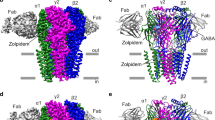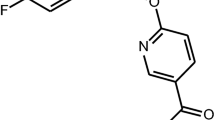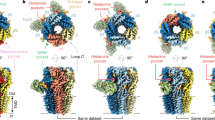Abstract
Classical benzodiazepines (BZs) exert anxiolytic, sedative, hypnotic, muscle relaxant, anticonvulsive, and amnesic effects through potentiation of neurotransmission at GABAA receptors containing α1, α2, α3 or α5 subunits. Genetic studies suggest that modulation at the α1 subunit contributes to much of the adverse effects of BZs, most notably sedation, ataxia, and amnesia. Hence, BZ site ligands functionally inactive at GABAA receptors containing the α1 subunit are considered to be promising leads for novel, anxioselective anxiolytics devoid of sedative properties. In pursuing this approach, we used two-electrode voltage clamp experiments in Xenopus oocytes expressing recombinant GABAA receptor subtypes to investigate functional selectivity of three newly synthesized BZ site ligands and also compared their in vivo behavioral profiles. The compounds were functionally selective for α2-, α3-, and α5-containing subtypes of GABAA receptors (SH-053-S-CH3 and SH-053-S-CH3-2′F) or essentially selective for α5 subtypes (SH-053-R-CH3). Possible influences on behavioral measures were tested in the elevated plus maze, spontaneous locomotor activity, and rotarod test, which are considered primarily predictive of the anxiolytic, sedative, and ataxic influence of BZs, respectively. The results confirmed the substantially diminished ataxic potential of BZ site agonists devoid of α1 subunit-mediated effects, with preserved anti-anxiety effects at 30 mg/kg of SH-053-S-CH3 and SH-053-S-CH3-2′F. However, all three ligands, dosed at 30 mg/kg, decreased spontaneous locomotor activity, suggesting that sedation may be partly dependent on activity mediated by α5-containing GABAA receptors. Hence, it could be of importance to avoid substantial agonist activity at α5 receptors by candidate anxioselective anxiolytics, if clinical sedation is to be avoided.
Similar content being viewed by others
Log in or create a free account to read this content
Gain free access to this article, as well as selected content from this journal and more on nature.com
or
References
Atack JR, Bayley PJ, Fletcher SR, McKernan RM, Wafford KA, Dawson GR (2006a). The proconvulsant effects of the GABA(A) alpha5 subtype-selective compound RY-080 may not be alpha5-mediated. Eur J Pharmacol 548: 77–82.
Atack JR, Pike A, Marshall G, Stanley J, Lincoln R, Cook SM et al (2006b). The in vivo properties of pagoclone in rat are most likely mediated by 5′-hydroxy pagoclone. Neuropharmacology 50: 677–689.
Atack JR, Wafford KA, Tye SJ, Cook SM, Sohal B, Pike A et al (2006c). TPA023 [7-(1,1-dimethylethyl)-6-(2-ethyl-2H-1,2,4-triazol-3-ylmethoxy)-3-(2-fluoropheny l)-1,2,4-triazolo[4,3-b]pyridazine], an agonist selective for alpha2- and alpha3-containing GABAA receptors, is a nonsedating anxiolytic in rodents and primates. J Pharmacol Exp Ther 316: 410–422.
Basile AS, Lippa AS, Skolnick P (2004). Anxioselective anxiolytics: can less be more? Eur J Pharmacol 500: 441–451.
Bohlhalter S, Weinmann O, Möhler H, Fritschy JM (1996). Laminar compartmentalization of GABAA-receptor subtypes in the spinal cord: an immunohistochemical study. J Neurosci 16: 283–297.
Bourin M, Briley M (2004). Sedation, an unpleasant, undesirable and potentially dangerous side-effect of many psychotropic drugs. Hum Psychopharmacol 19: 135–139.
Chang Y, Wang R, Barot S, Weiss DS (1996). Stoichiometry of a recombinant GABAA receptor. J Neurosci 16: 5415–5424.
Collinson N, Kuenzi FM, Jarolimek W, Maubach KA, Cothliff R, Sur C et al (2002). Enhanced learning and memory and altered GABAergic synaptic transmission in mice lacking the alpha 5 subunit of the GABAA receptor. J Neurosci 22: 5572–5580.
Crestani F, Keist R, Fritschy JM, Benke D, Vogt K, Prut L et al (2002). Trace fear conditioning involves hippocampal alpha5 GABA(A) receptors. Proc Natl Acad Sci USA 99: 8980–8985.
Crestani F, Martin JR, Möhler H, Rudolph U (2000). Resolving differences in GABAA receptor mutant mouse studies. Nat Neurosci 3: 1059.
Dailly E, Hascoet M, Colombel MC, Jolliet P, Bourin M (2002). Relationship between cerebral pharmacokinetics and anxiolytic activity of diazepam and its active metabolites after a single intra-peritoneal administration of diazepam in mice. Hum Psychopharmacol 17: 239–245.
Dias R, Sheppard WF, Fradley RL, Garrett EM, Stanley JL, Tye SJ et al (2005). Evidence for a significant role of alpha 3-containing GABAA receptors in mediating the anxiolytic effects of benzodiazepines. J Neurosci 25: 10682–10688.
Facklam M, Schoch P, Bonetti EP, Jenck F, Martin JR, Moreau JL et al (1992). Relationship between benzodiazepine receptor occupancy and functional effects in vivo of four ligands of differing intrinsic efficacies. J Pharmacol Exp Ther 261: 1113–1121.
Fuchs K, Zezula J, Slany A, Sieghart W (1995). Endogenous [3H]flunitrazepam binding in human embryonic kidney cell line 293. Eur J Pharmacol 289: 87–95.
Griebel G, Perrault G, Simiand J, Cohen C, Granger P, Decobert M et al (2001). SL651498: an anxioselective compound with functional selectivity for alpha2-and alpha3-containing gamma-aminobutyric acid(A) (GABA(A)) receptors. J Pharmacol Exp Ther 298: 753–768.
He X, Huang Q, Ma C, Yu S, McKernan R, Cook JM (2000). Pharmacophore/receptor models for GABA(A)/BzR α2β3γ2, α3β3γ2 and α4β3γ2 recombinant subtypes. Included volume analysis and comparison to α1β3γ2, α5β3γ2, and α6β3γ2 subtypes. Drug Des Discov 17: 131–171.
Jennings AS, Lewis RT, Russell MG, Hallett DJ, Street LJ, Castro JL et al (2006). Imidazo[1,2-b][1,2,4]triazines as alpha2/alpha3 subtype selective GABA A agonists for the treatment of anxiety. Bioorg Med Chem Lett 16: 1477–1480.
Kelley AE (1993). Locomotor activity and exploration. In: van Haaren F (ed). Techniques in the Behavioral and Neural Sciences, vol 10. Methods in Behavioral Pharmacology. Elsevier: New York. pp 499–518.
Lader MH (1999). Limitations on the use of benzodiazepines in anxiety and insomnia: are they justified? Eur Neuropsychopharmacol 9 (Suppl 6): S399–S405.
Licata SC, Platt DM, Cook JM, Sarma PV, Griebel G, Rowlett JK (2005). Contribution of GABAA receptor subtypes to the anxiolytic-like, motor, and discriminative stimulus effects of benzodiazepines: studies with the functionally selective ligand SL651498 [6-fluoro-9-methyl-2-phenyl-4-(pyrrolidin-1-yl-carbonyl)-2,9-dihydro-1H-pyridol[ 3,4-b]indol-1-one]. J Pharmacol Exp Ther 313: 1118–1125.
Liu R, Zhang P, McKernan RM, Wafford K, Cook JM (1995). Synthesis of novel imidazobenzodiazepines selective for the α5β2γ2 (Bz5) GABAA/benzodiazepine receptor subtype. Med Chem Res 5: 700–709.
Low K, Crestani F, Keist R, Benke D, Brunig I, Benson JA et al (2000). Molecular and neuronal substrate for the selective attenuation of anxiety. Science 290: 131–134.
McKernan RM, Rosahl TW, Reynolds DS, Sur C, Wafford KA, Atack JR et al (2000). Sedative but not anxiolytic properties of benzodiazepines are mediated by the GABA(A) receptor alpha1 subtype. Nat Neurosci 3: 587–592.
Porsolt RD, McArthur RA, Lenegre A (1993). Psychotropic screening procedures. In: van Haaren F (ed). Techniques in the Behavioral And Neural Sciences, vol 10. Methods in Behavioral Pharmacology. Elsevier: New York. pp 23–51.
Rowlett JK, Platt DM, Lelas S, Atack JR, Dawson GR (2005). Different GABAA receptor subtypes mediate the anxiolytic, abuse-related, and motor effects of benzodiazepine-like drugs in primates. Proc Natl Acad Sci USA 102: 915–920.
Rudolph U, Crestani F, Benke D, Brunig I, Benson JA, Fritschy JM et al (1999). Benzodiazepine actions mediated by specific gamma-aminobutyric acid(A) receptor subtypes. Nature 401: 796–800.
Rudolph U, Möhler H (2004). Analysis of GABAA receptor function and dissection of the pharmacology of benzodiazepines and general anesthetics through mouse genetics. Annu Rev Pharmacol Toxicol 44: 475–498.
Rudolph U, Möhler H (2006). GABA-based therapeutic approaches: GABA(A) receptor subtype functions. Curr Opin Pharmacol 6: 18–23.
Russell MG, Carling RW, Street LJ, Hallett DJ, Goodacre S, Mezzogori E et al (2006). Discovery of imidazo[1,2-b][1,2,4]triazines as GABA(A) alpha2/3 subtype selective agonists for the treatment of anxiety. J Med Chem 49: 1235–1238.
Sanger D, Willner P, Bergman J (2003). Applications of behavioural pharmacology in drug discovery. Behav Pharmacol 14: 363–367.
Sanger DJ, Morel E, Perrault G (1996). Comparison of the pharmacological profiles of the hypnotic drugs, zaleplon and zolpidem. Eur J Pharmacol 313: 35–42.
Savić MM, Obradoviæ DI, Ugrešiæ ND, Bokonjiæ DR (2003). The influence of diazepam on atropine reversal of behavioural impairment in dichlorvos-treated rats. Pharmacol Toxicol 93: 211–218.
Savić MM, Obradović DI, Ugrešiæ ND, Cook JM, Yin W, Van Linn M et al (2006). Benzodiazepine site inverse agonists and locomotor activity in rats: bimodal and biphasic influence. Pharmacol Biochem Behav 84: 35–42.
Sieghart W, Sperk G (2002). Subunit composition, distribution and function of GABAA receptor subtypes. Curr Opin Med Chem 2: 795–816.
Sigel E (1987). Properties of single sodium channels translated by Xenopus oocytes after injection with messenger ribonucleic acid. J Physiol 386: 73–90.
Sigel E, Baur R, Trube G, Möhler H, Malherbe P (1990). The effect of subunit composition of rat brain GABAA receptors on channel function. Neuron 5: 703–711.
Sigel E, Buhr A (1997). The benzodiazepine binding site of GABAA receptors. Trends Pharmacol Sci 18: 425–429.
van Rijnsoever C, Tauber M, Choulli MK, Keist R, Rudolph U, Möhler H et al (2004). Requirement of alpha5-GABAA receptors for the development of tolerance to the sedative action of diazepam in mice. J Neurosci 24: 6785–6790.
Vogel HG (2002). Drug Discovery and Evaluation. Springer: Berlin.
Whiting PJ (2006). GABA-A receptors: a viable target for novel anxiolytics? Curr Opin Pharmacol 6: 24–29.
Zhang W, Koehler KF, Zhang P, Cook JM (1995). Development of a comprehensive pharmacophore model for the benzodiazepine receptor. Drug Des Discov 12: 193–248.
Acknowledgements
This work was supported in part by NIMH 46851 (JMC) and by The Ministry of Science and Environment Protection, R Serbia—Grant No. 145022B (MMS). We acknowledge the support of this work by the Research Growth Initiative of the University of Wisconsin-Milwaukee.
Author information
Authors and Affiliations
Corresponding author
Rights and permissions
About this article
Cite this article
Savić, M., Huang, S., Furtmüller, R. et al. Are GABAA Receptors Containing α5 Subunits Contributing to the Sedative Properties of Benzodiazepine Site Agonists?. Neuropsychopharmacol 33, 332–339 (2008). https://doi.org/10.1038/sj.npp.1301403
Received:
Revised:
Accepted:
Published:
Issue date:
DOI: https://doi.org/10.1038/sj.npp.1301403
Keywords
This article is cited by
-
Zolpidem reduces pain intensity postoperatively: a systematic review and meta-analysis of the effect of hypnotic medicines on post-operative pain intensity
Systematic Reviews (2020)
-
The α5-Containing GABAA Receptors—a Brief Summary
Journal of Molecular Neuroscience (2019)
-
Negative allosteric modulation of alpha 5-containing GABAA receptors engenders antidepressant-like effects and selectively prevents age-associated hyperactivity in tau-depositing mice
Psychopharmacology (2018)
-
Glutamatergic and GABAergic modulations of ultrasonic vocalizations during maternal separation distress in mouse pups
Psychopharmacology (2009)
-
Contribution of α1 subunit-containing γ-aminobutyric acidA (GABAA) receptors to motor-impairing effects of benzodiazepines in squirrel monkeys
Psychopharmacology (2009)



